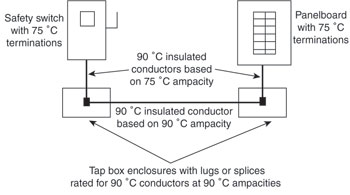Few, if any, products of manufactured equipment (disconnects, panelboards, etc) will be listed as a system for you to use take credit for the 90C conductor ampacity values. And this is the case, even if you have lugs that are labeled AL9CU. The equipment as as system must be rated for 90C, not just the lug manufactured as part of the equipment.
It is only when you use a separately installed connector in the field on both sides, that is rated for 90C, that you can use the 90C values at terminations. Such connectors do exist. You need 90C insulation on both sides, and a connector that is listed for 90C. The segment of wire connecting to a piece of manufactured equipment needs 75C wire sizing.
I haven't seen an exact code reference clarifying whether or not this splicing needs to occur in a separate enclosure. For a conservative approach, it should occur in a separate enclosure.


